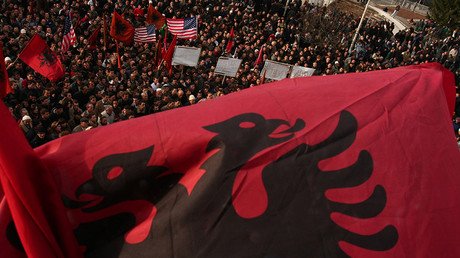Propaganda video of NATO’s smoke and mirrors over Kosovo hides some inconvenient truths

A new and strangely timed NATO video paints a flattering – and entirely fraudulent – picture of the alliance’s mission in Kosovo, a Serbian province it occupied in 1999 that now styles itself an independent state.
What NATO wants the general public to believe is that it had no choice but to intervene in 1999, because “Kosovo Albanian forces” were fighting the “policy of ethnic cleansing” of Yugoslav President Slobodan Milosevic, who was “not interested” in a peaceful solution.
“The conflict had created this dire humanitarian crisis, it was threatening the stability of the region, and the security of the region, and NATO's intervention was therefore necessary,” NATO Deputy Assistant Secretary General for Operations Jonathan Parish says at one point in the nine-and-a-half-minute video, released last Friday.
Parish’s fantasies have little to do with actual history, in which NATO attacked what was then Yugoslavia in violation of its own and UN charters. The “peaceful solution” the Alliance proposed was in fact an ultimatum designed to be rejected. The 78-day air campaign that followed was waged on behalf of the “Kosovo Liberation Army,” (KLO) an organization of ethnic Albanian militants even the US at one point considered terrorists. The war ended in a negotiated armistice and the UN Security Council Resolution 1244, guaranteeing Yugoslavia’s territorial integrity while authorizing an international peacekeeping mission: Kosovo Force (KFOR).
It was the KLA that actually had a policy of “ethnic cleansing,” killing and expelling most of the province’s non-Albanians, burning and looting their properties, leaving wrecked churches and desecrated cemeteries in its wake. Though NATO says KFOR’s mandate is to “impartially provide a safe and secure environment and freedom of movement for all inhabitants of Kosovo,” in practice the alliance troops mostly watched as the KLA conducted its reign of terror.
March 17, 2004: pogrom of Kosovo Serbs at the hands of tens of thousands of Albanian extremists who clashed with international forces who tried to protect the Serbs, but largely failed. https://t.co/YWdqs9TT6v via @YouTube
— Mladen Mrdalj (@mladen_mrdalj) March 17, 2019
When KFOR did get around to doing its job, it was to safeguard the few remaining Serbs in scattered enclaves, surrounded by barbed wire and under constant threat of Albanian violence. One such enclave is Gracanica, where NATO found a Serb restaurant owner to recite its scripted lines like a hostage that he was.
In 2007, then-KFOR commander, a French general named Xavier de Marnhac, actually said the ethnic tensions will eventually have a “biological end” as these remaining Serbs die of old age.
Perhaps itching to speed up the process a bit, in March 2004 a KLA propagandist launched a story about Serbs drowning several Albanian children in a river – setting off a three-day rampage by some 50,000 ethnic Albanians across the province. With a handful of honorable exceptions, KFOR troops did little to nothing to stop the pogrom. The NATO video makes no mention of it, either – though it does suggest KFOR is well-versed in “crowd and riot control” by showing some training footage.
Also on rt.com Kosovo: A decade of dependenceAlmost eight minutes into the video, there is at last a moment of truth: a display of the national flag of Albania, with a black eagle on a red field, instead of the fake blue-yellow-white banner created for the equally fake “independent” Kosovo by its NATO overlords in 2008.
NATO’s illegal intervention in Kosovo actually permanently destabilized the Balkans, as evidenced by the subsequent ethnic Albanian rebellion in what is now North Macedonia. Its unraveling of international law also produced fallout in Europe and elsewhere in the world.
KFOR’s continued existence is not due to any of that, however, but to NATO’s reluctance to leave a region it considers conquered. Further frustrating its 20-year effort is Serbia’s ongoing refusal to recognize Kosovo as an independent state. In this, Belgrade is backed by Russia, China, and about half the world’s governments, representing two thirds of the world’s population.
Watching NATO’s pep talk to itself, one question would not leave me alone. Why now? The actual anniversary of KFOR’s mission was in June, the anniversary of the war in March – November 15 does not figure as an important date at all. Except, of course, just a week prior the French President Emmanuel Macron called NATO “brain dead” and questioned the alliance’s ongoing usefulness.
Though the video has surely been in production longer than a week, I wouldn’t be the least bit surprised if its release was rushed to give NATO something to counter Macron’s narrative. It might be a pack of lies, but that’s beside the point; the audience for which it was intended will eagerly eat it up.
NATO’s real weapons have never been bombs, tanks or boots on the ground, you see, but perception management. The people behind that colossal con simply have to keep spinning, lest one day their marks wake up and realize they’ve been had. So they drone on and on about “excellence” and “Russian threats” and “peace and democracy,” and a bright future in diverse communities that are anything but – hoping that the smoke and mirrors will keep working until the inconvenient truths meet a “biological end.”
Like this story? Share it with a friend!
The statements, views and opinions expressed in this column are solely those of the author and do not necessarily represent those of RT.















